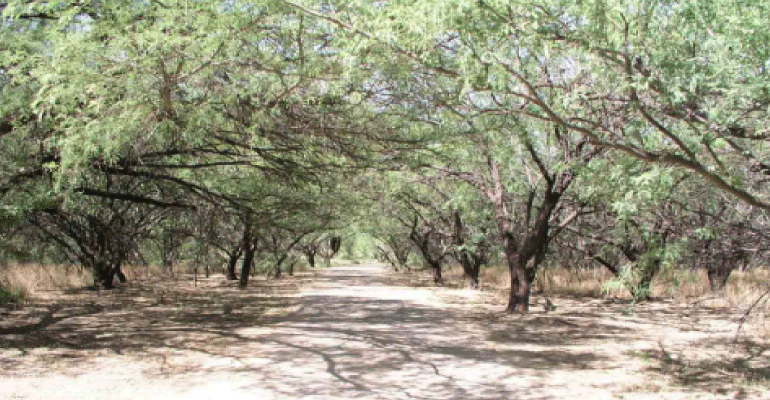
Southern Arizona ranchers have been battling mesquite trees for almost 100 years. The principal reason is that mesquite trees and shrubs suck up the water and thereby degrade the range making it less suitable for raising livestock. It also makes the grasslands less accommodating to wildlife.
Mesquite is a very hardy plant that produces an abundance of seed pods. The seeds and pods are collected and stored by rodents. Many animals, including livestock and deer, eat the seed pods, but the seeds themselves pass through undigested and are deposited with some fertilizer.
The problem as described to me by a southern Arizona rancher:
Southern Arizona is characterized by intermittent drought. This results in marked death loss of the perennial forage grasses, however, drought seldom causes death of whole mesquite plants. Mesquite have a long tap root enabling it to reach underground moisture and can tolerate drought. Grasses do not have that advantage. As the tree grows it demands more moisture. The result is each year, depending on the rainfall, less and less forage is produced as the tree shades the ground and quickly takes up the moisture. As the mesquite grow, noxious plants also become established with their deeper roots which make them drought resistant. These include burroweed and snakeweed. These also crowd out grass. As the ground is bare, when a heavy rain falls there is not grass and grass roots to hold the soil so erosion becomes an issue.
According to University of Arizona Technical Bulletin 74, published in 1938:
- Certain range lands of the grassland type in southern Arizona are undergoing an invasion by the mesquite tree and noxious shrubs to the extent that the native stand of palatable forage is being materially reduced. The development of this problem has taken place at a pace gradual enough that its seriousness was not fully realized by stockmen until the cumulative effects of some forty years’ transition in the vegetation type of the affected areas became increasingly apparent.
- The report goes on to discuss various methods of mesquite eradication including use of petroleum products, arsenic, acid sprays, and other chemical means. These methods proved ultimately ineffective. Petroleum did not kill the roots so the mesquite soon sprouted new growth. The chemicals remained on the stumps and were thus dangerous to livestock and wildlife. Burning individual trees was also ineffective. Only sodium arsenite solution would kill the roots, but it was difficult to prepare and handle.
The US Department of Agriculture weighed in with Circular 908 published in 1952:
- One of the most serious and perplexing problems in southeastern Arizona is mesquite invasion of grasslands. Mesquite occurs there in varying degrees of abundance on 9 million acres of range land. The problem is likewise serious elsewhere in the Southwest. Mesquite is now firmly established on considerably more than 70 million acres of range in Texas, New Mexico, and Arizona. An estimated half of the area now occupied by mesquite has been invaded since the advent of domestic livestock. The increase of mesquite is viewed with ever-increasing alarm by range operators.
- The principal reasons for concern are : (1) Mesquite, even under moderate grazing use, is still persistently increasing both by invading open grassland and by thickening of old stands. (2) Cutting mesquite, especially in bottom-land areas, usually results in an impenetrable thicket of sprout regrowth and new seedlings. In many of these “jungles,” grazing has had to be abandoned. (3) Livestock handling costs are increased, especially in dense upland mesquite thickets where it is difficult to gather livestock for market or to find screwworm-infested animals for treatment. (4) Increases in mesquite are usually accompanied by decreases in quantity and quality of perennial grass forage and corresponding reductions in livestock production. (5) Still more serious from a long-time viewpoint is the accelerated erosion generally found on uplands as well as bottom lands wherever mesquite has encroached.
The USDA further opines on the cause of the mesquite invasion:
- The probability is that neither protection nor heavy grazing has much to do with the increase of shrubs here, but it is primarily the direct result of the prevention of fires.
I spoke with several ranchers who are battling mesquite in southern Arizona. For many years they have been using mechanical means to cut the trees and shrubs and digging out the roots. They try to remove at least 80% of the mesquite. Studies at the Santa Rita Experimental Range show that removing about 80% and leaving some mature trees makes the range more amenable to wildlife than thick mesquite stands or open range.
Before removal work can be done, the ranchers have to make surveys for endangered species such as the Pima Pineapple Cactus, which was listed in 1993 (and there is still no recovery plan). They also have to survey for cultural resources.
The mechanical method means bulldozers to knock down the trees and dig up the roots. One rancher told me it costs $300-$400 per acre and can get only one acre per hour. This is an expensive and tedious operation.
More recently, ranchers have been experimenting with chemical warfare again. Dow Chemical has developed an herbicide that is specific for mesquite. It is deployed by helicopter spraying. This costs about $106 per acre and can cover 80 acres per hour. This is similar to crop dusting operations used on farms.
The ranchers say another main reason for mesquite removal is to reduce soil erosion and restore native grasses. Since chemical removal has begun, ranchers have noticed return of many native grass species.
The war continues. Controlling mesquite makes the range more productive, saves water, and benefits wildlife.
For information on traditional use of mesquite trees see:
Note to readers:
- Index with links to all my ADI articles: http://wp.me/P3SUNp-1pi
- My comprehensive 28-page essay on climate change: http://wp.me/P3SUNp-1bq
